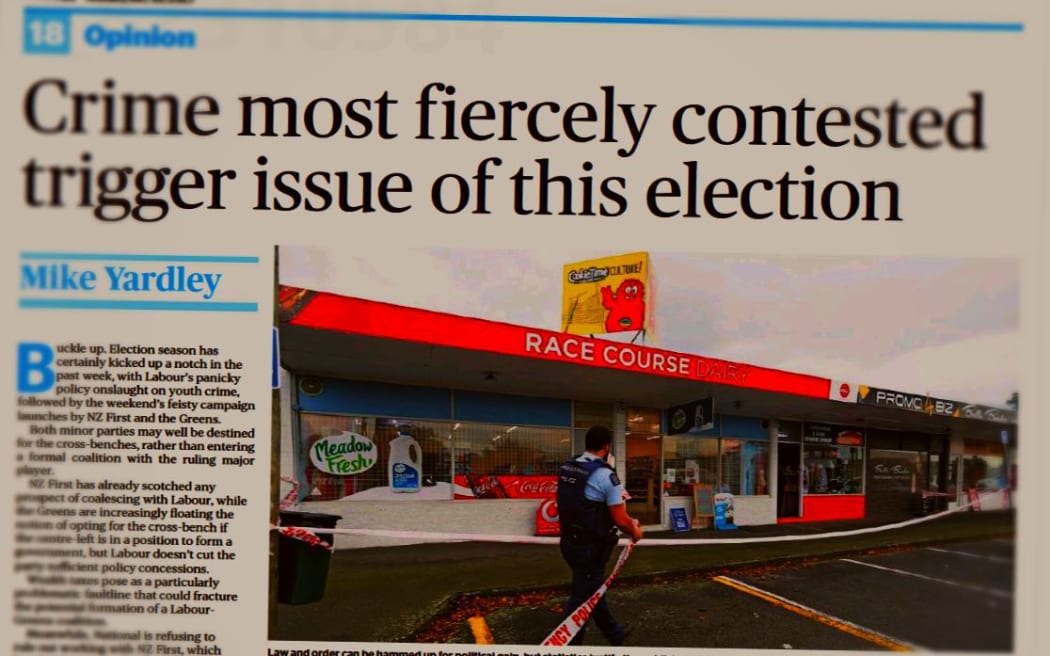Political calls to crack down on crime are echoing in our media ahead of the upcoming election - not for the first time. Two seasoned journalists showed this was part of a pattern in a report on crime coverage which recommended new approaches. It was commissioned five years ago - but never saw the light of day.

Crime and punishment is usually a big issue when elections roll around. Photo: The Press
Picture this: an election is looming and one of the electorate's top concerns is seemingly out-of-control crime.
Pressure groups are hammering the message that offenders are getting off lightly.
They've got support from National, repeatedly accusing the incumbent Labour government of being soft on crime.
Expert, evidence-based analysis of criminal justice is increasingly drowned out in the media by a clamour for more punitive measures.
On the back foot and losing the public debate, Labour starts talking up legislative changes to lengthen sentences and increase penalties for crimes that hit the headlines most often.
That, of course, is a description of the 2002 general election, where the Sensible Sentencing Trust and National Party leader Bill English spearheaded a tough on crime narrative following a number of high-profile murders.
If it sounds familiar, it’s because history repeats and everything old becomes new again in the justice debate from the 1990 election, where the National Party campaigned on a 'return to a decent society' to the upcoming one in October.
All that is spelled out in a 227-page report titled 'Developing good practice in criminal justice and journalism'.
It was commissioned in 2018 by the Safe and Effective Justice Advisory Group (Te Uepū Hāpai i te Ora), and written by the current editor of Newsroom Pro and former editor of the Sunday Star-Times, Jonathan Milne - and by David Fisher, a senior journalist at the New Zealand Herald and former chief reporter at the Herald on Sunday.
"It is important our audiences are able to form an accurate picture of the communities in which they live through the media they consume. Surveys on public perception of crime show this is not the case. The surveys also show our communities develop these inaccurate perceptions through the media they consume," the report concluded.
The report calls for reporters to include context and facts about crime – to explain the 'why', rather than just the 'what' and the 'how'.
In the authors' eyes, that means doing sometimes difficult things like including the voices of offenders in crime coverage.
Other recommendations include a call to set up a centralised toolkit of crime statistics and research summaries, ensuring more diversity in our newsrooms, and trying to make coverage of violent crime more proportionate to the frequency it actually occurs.
It even gets into the nitty-gritty of reporting terminology, urging journalists to avoid crime cliches such as 'blood-spattered,' 'slaughter,' or 'outrage' where possible.
All those things might have helped foster more nuanced, informed reporting ahead of our current election.
The Safe and Effective Justice Advisory Group hoped so.
"The Media Working Group Project is establishing best practice guidelines for crime reporting and we look forward to seeing the impact," it said when it reported back.
But the 'Developing good practice in criminal justice and journalism' report was never released.
One of the report’s authors – Jonathan Milne – and the person who commissioned it - University of Canterbury senior lecturer and director of criminal justice Dr Jarrod Gilbert – told Mediawatch they've found the current media coverage of crime disappointing.
Milne said it was not always tethered to the actual statistics on crime, which have generally trended down for decades.
He pointed out reported crime peaked in 1992, when 1322 crimes per 10,000 people were recorded. It has declined to just more than half that rate since.
"But you wouldn't know it from the peaks and troughs and public debate. You can see the 1996 election. You can see the 2002 election. You can see the 2011 election and the way we're going into the 2023 election, where this law and order stuff is coming into the fore, it hasn't really been about a steady increase in a pattern of crime."
Gilbert said perception was often a stronger force than reality in driving spikes of concern about law and order, and research showed media coverage could have a distorting effect.
"We can see that through surveys on which way crime rates are trending, that the public always overestimates the amount of crime. But interestingly, if you ask them about crime in their own community that they know and can see and experience, they tend to be far more accurate. And that's because they learn about other places, of course, through the media."
Milne said that showed the importance of more nuanced coverage on crime in the upcoming election campaign, with the media delivering crime statistics and discussion of what was driving the offending.
"This is where I think the role of the media is critically important. And I and my colleagues really need to act responsibly. I think pretty much every media organisation has written into its core principles that we will work together to try and contribute constructively to our communities. And this is a real chance for us to do so," he said.
"The impact of crime is devastating on the victims on the communities and also on the communities of the offenders. Those are often the same communities. But I also know that the impact of living in fear of crime can be harmful as well.
"The media has a really important role to play in putting this in perspective, and showing where the real dangers of crime are."
The report notes a Ministry of Justice study in 2003 found 83 percent of New Zealanders wrongly believed crime was increasing. A 2009 analysis found "an overwhelming public belief that crime has got worse", despite the murder rate dropping by almost half. Colmar Brunton surveys in 2014 and 2016 for the Ministry of Justice showed "continued perceptions that violent crime was increasing and that prison was an effective deterrent."
Milne highlighted recent media coverage of former justice minister Kiri Allan, who was criticised by several commentators for holding up a sheet of statistics in parliament showing crime rates trending down.
"Well, I don't think that's the right response. I think we need to take an evidence-based approach, we do need to step back, we do need to be a little bit cold, and distant and aloof sometimes and say, 'what's really happening here?', rather than just responding to emotion because I said earlier, responding to emotion only heightens fear, and that's damaging to people as well."
Gilbert said politicians and the media were drawn to 'tough on crime' narratives partly because they work, whether in winning votes or drawing eyeballs and clicks to stories.
He acknowledged that complex solutions - even if they were backed by research - did not cut through in the same way as a call to crack down on crime.
But simplistic reporting ultimately harmed the audiences which news organisations said they were trying to serve, he said.
"We've talked about it a lot here would be just adding that all-important context - putting these things into a perspective of longer term trends, explaining whether or not these are one-offs or that there is a cluster that perhaps we need to need to address. I think that would go a long way to solving to making the reporting more sober and intellectual and moving from the gut to the brain."
'Developing good practice in criminal justice and journalism' also lists eight "oft-quoted myths that simply don’t stack up on the facts".
- Severe penalties are effective deterrents to crime (excluding fraud)
- Offenders are just bad people who can’t be helped
- Victims usually don’t know the person who attacks them
- The typical victim is a young white, middle-class woman
- Violent crime is soaring
- Sex offenders are likely to reoffend in their new community
- Our prison muster is high because our crime rate is high
- Restorative justice is a soft option for offenders


